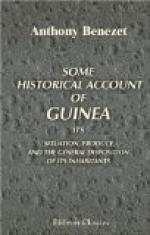An account of the shocking inhumanity, used in the carrying on of the slave-trade, as described by factors of different nations, viz. by Francis Moor, on the river Gambia; and by John Barbot, A. Brue, and William Bosman, through the coast of Guinea. Note. Of the large revenues arising to the Kings of Guinea from the slave-trade.
First, Francis Moor, factor for the English African company, on the river Gambia,[A] writes, “That there are a number of Negro traders, called joncoes, or merchants, who follow the slave-trade as a business; their place of residence is so high up in the country as to be six weeks travel from James Fort, which is situate at the mouth of that river. These merchants bring down elephants teeth, and in some years two thousand slaves, most of which, they say, are prisoners taken in war. They buy them from the different Princes who take them; many of them are Bumbrongs and Petcharies; nations, who each of them have different languages, and are brought from a vast way inland. Their way of bringing them is tying them by the neck with leather thongs, at about a yard distant from each other, thirty or forty in a string, having generally a bundle of corn or elephants teeth upon each of their heads. In their way from the mountains, they travel thro’ very great woods, where they cannot for some days get water; so they carry in skin bags enough to support them for a time. I cannot (adds Moor) be certain of the number of merchants who follow this trade, but there may, perhaps, be about an hundred, who go up into the inland country, with the goods which they buy from the white men, and with them purchase, in various countries, gold, slaves, and elephants teeth. Besides the slaves, which the merchants bring down, there are many bought along the river: These are either taken in war, as the former are, or men condemned for crimes; or else people stolen, which is very frequent.—Since the slave-trade has been used, all punishments are changed into slavery; there being an advantage on such condemnation, they strain for crimes very hard, in order to get the benefit of selling the criminal.”
[Footnote A: Moor, page 28.]
John Barbot, the French factor, in his account of the manner by which the slaves are procured, says,[A] “The slaves sold by the Negroes, are for the most part prisoners of war, or taken in the incursions they make in their enemies territories; others are stolen away by their neighbours, when found abroad on the road, or in the woods; or else in the corn fields, at the time of the year when their parents keep them there all the day to scare away the devouring small birds.” Speaking of the transactions on that part of Guinea called the Slave Coast, where the Europeans have the most factories, and from whence they bring away much the greatest number of slaves, the same author, and also Bosman[B] says, “The inhabitants of Coto do much mischief, in stealing those




